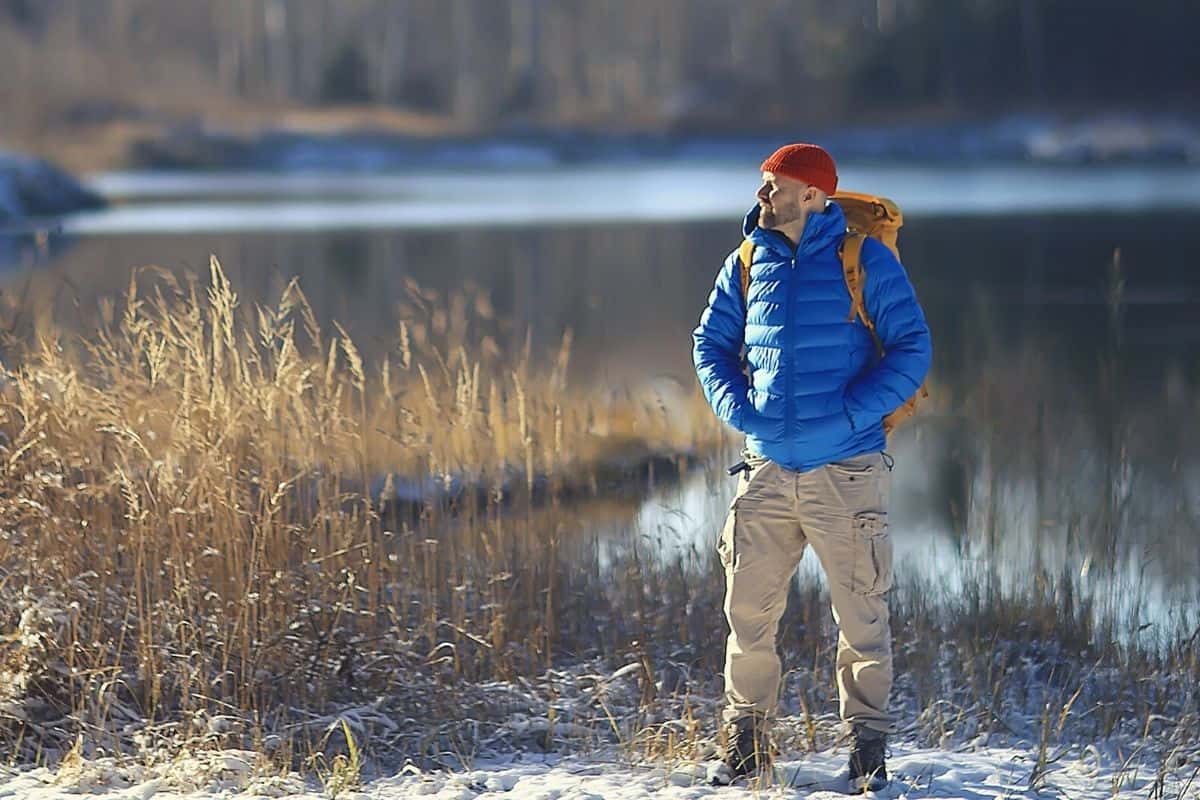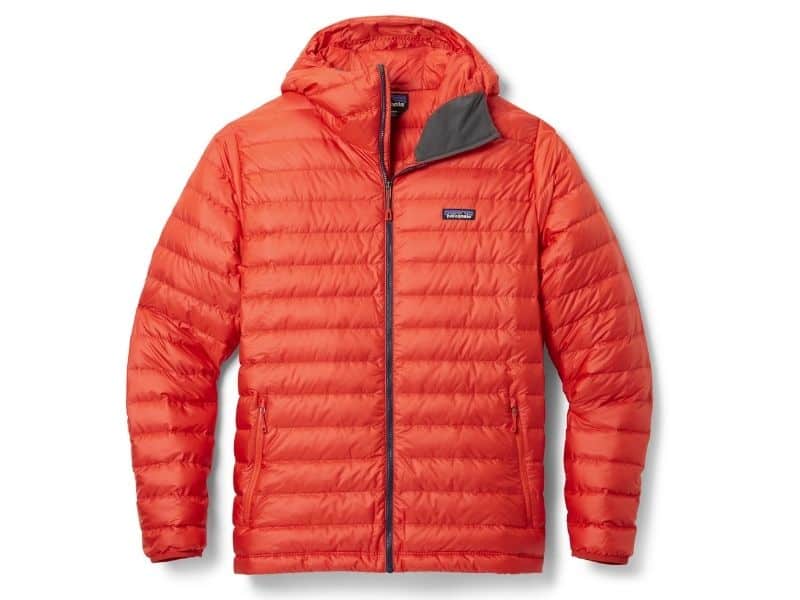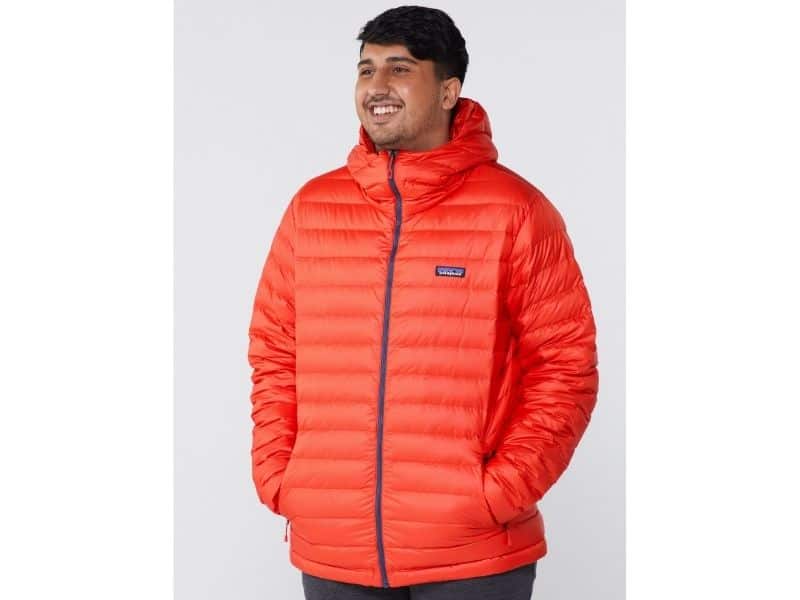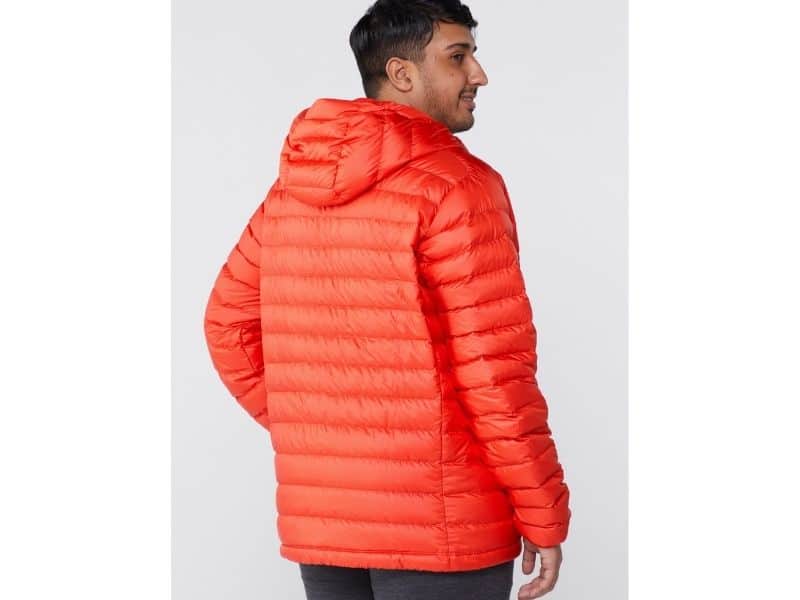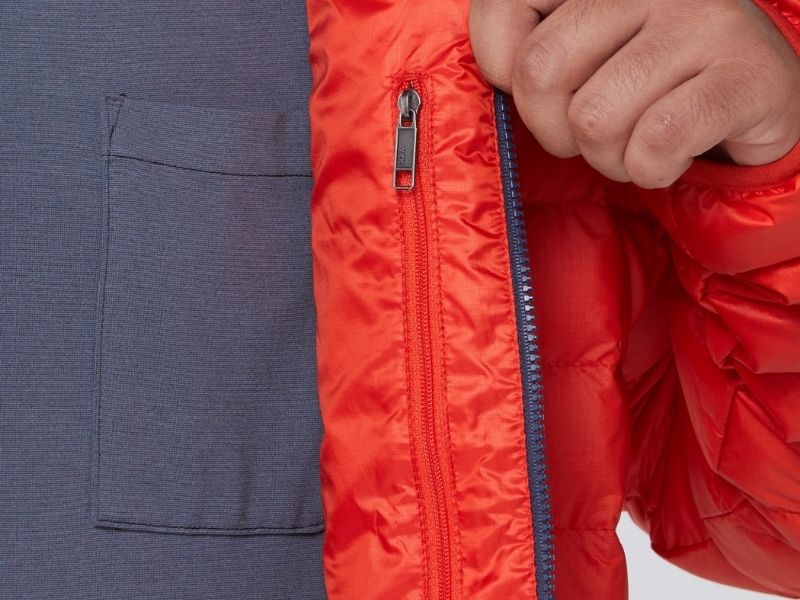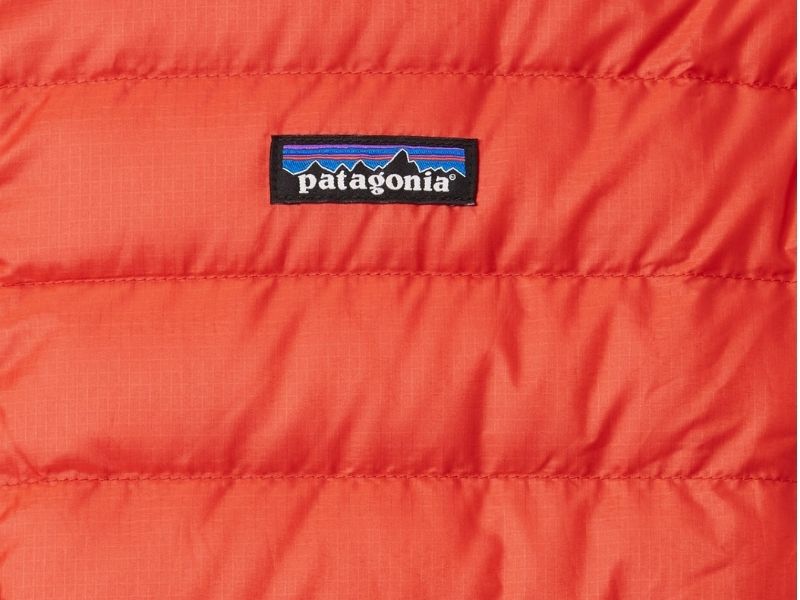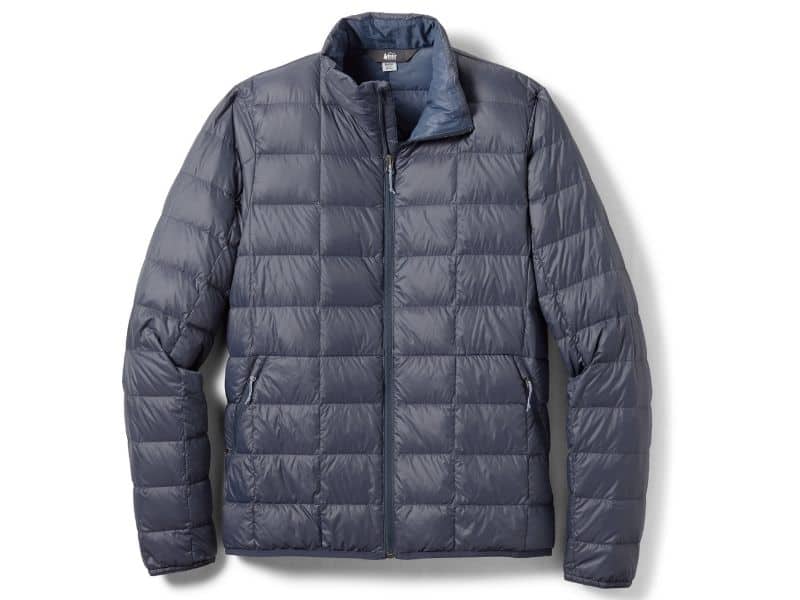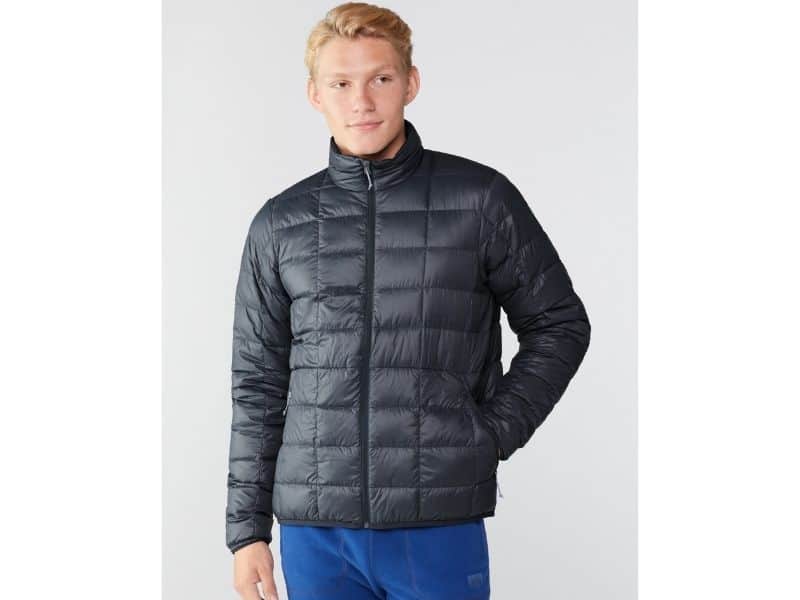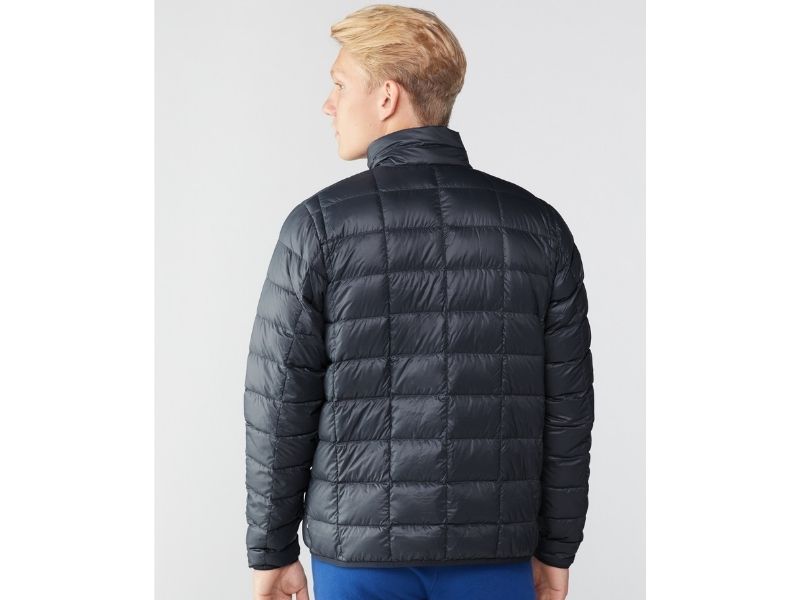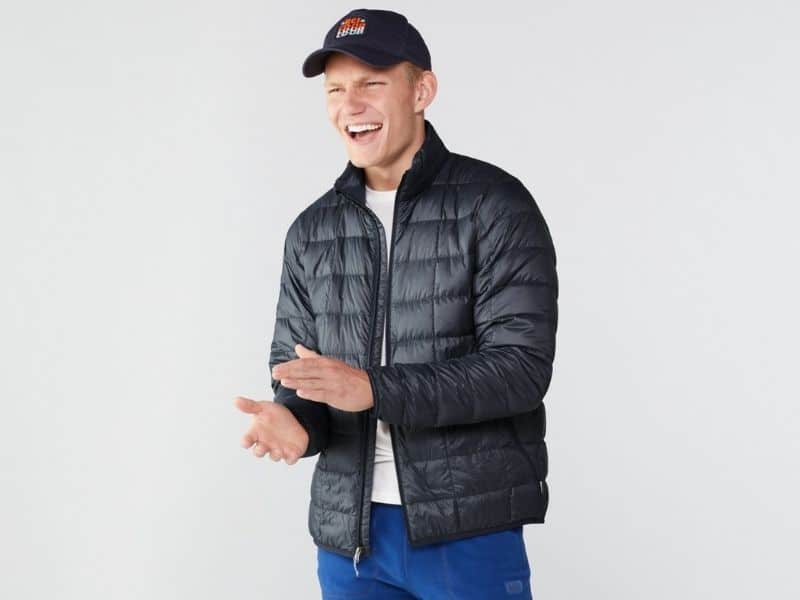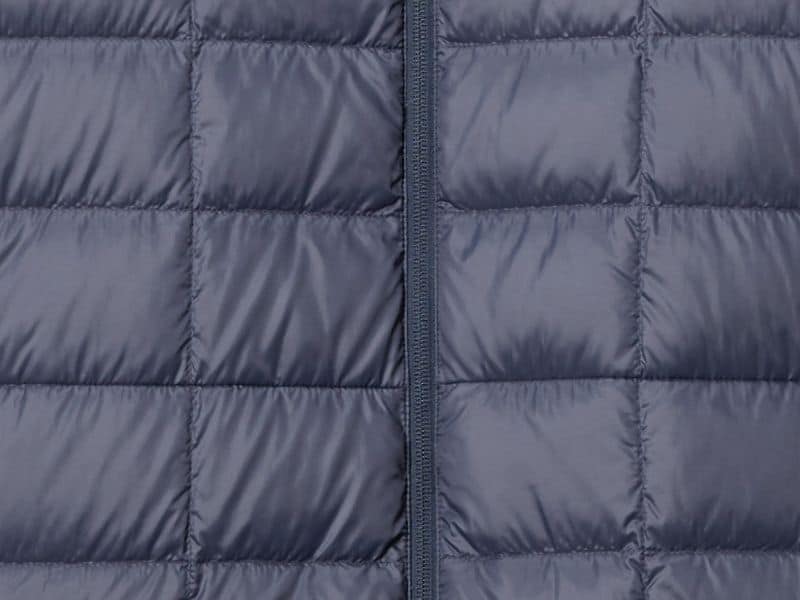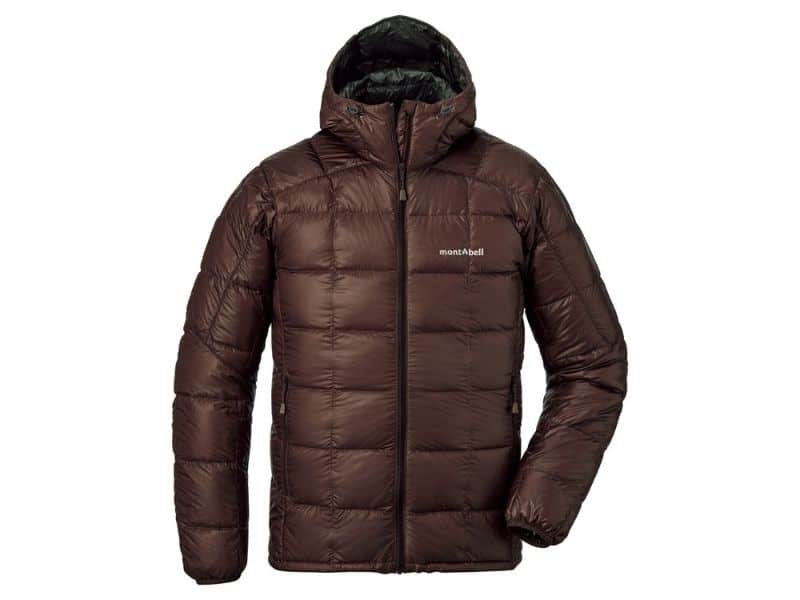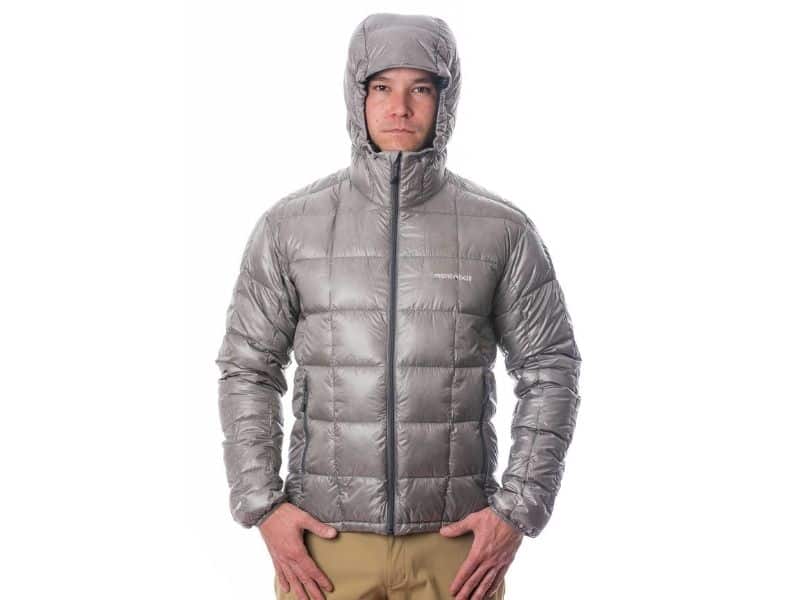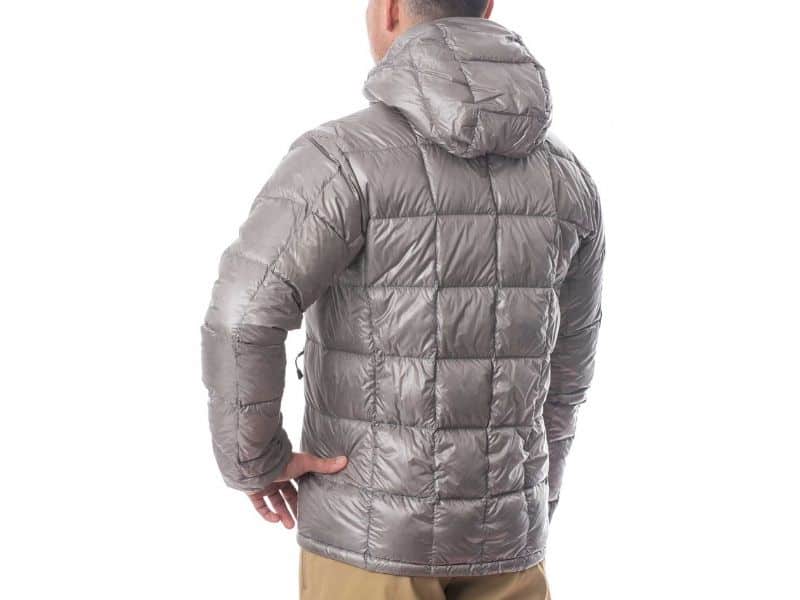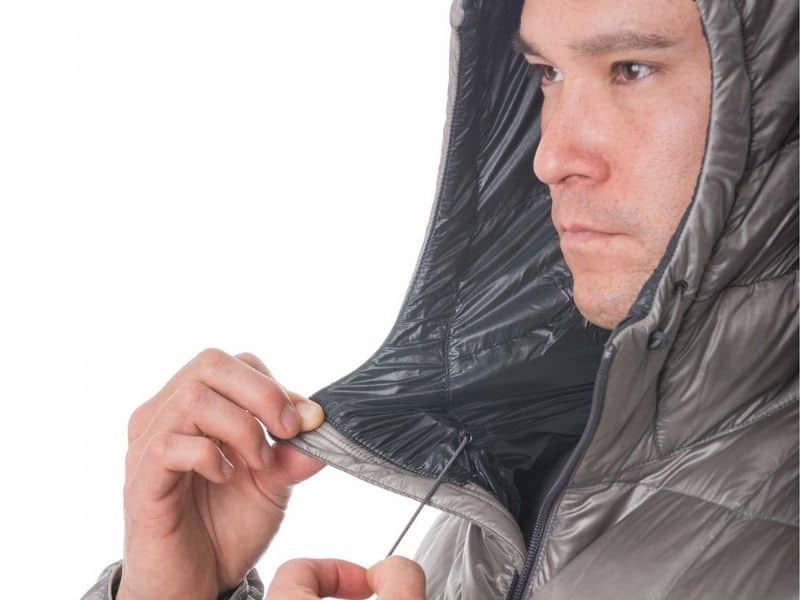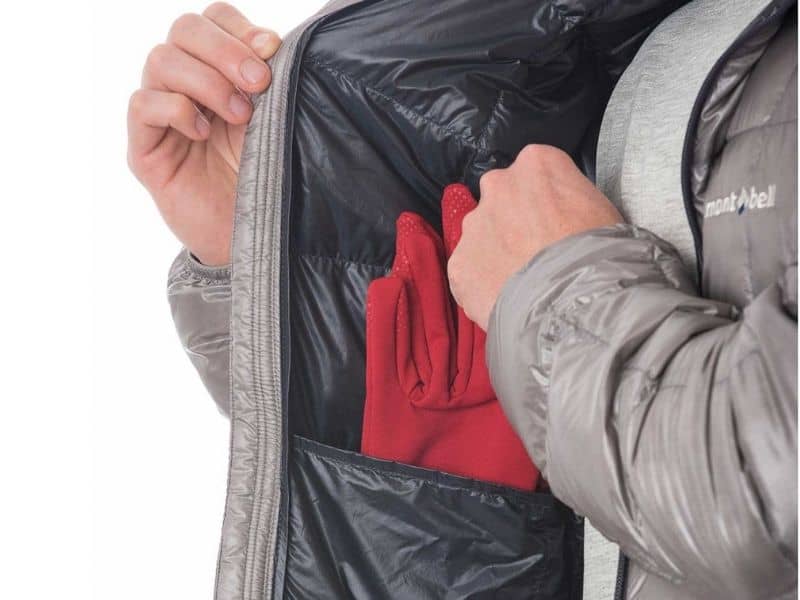Through the chilly Scottish highlands, high-elevation hikes in the Sierra Nevadas, and further afield, we’ve put many down jackets through their paces and have chosen the Mountain Hardwear Ghost Whisperer 2 as the best down jacket for the third year in a row due to its awesome warmth-to-weight ratio, fit, and top-notch features.
While the Ghost Whisperer is a high-quality down jacket, it might not be the right choice for you so we also have reviewed Mountain Hardwear Ghost Whisperer 2, Rab Neutrino Pro, Patagonia Down Sweater Hoody, Arc’teryx Cerium SL Hoodie, Rab Microlight Alpine, REI Co-op 650 2.0, MontBell Superior, Rab Cubit Stretch Hoody, Arc’teryx Atom LT, Outdoor Research Helium, Feathered Friends Eos, Cotopaxi Fuego Hooded, and the Mountain Hardwear Stretchdown Hoody.
There are many great down jackets to choose from, but how do you choose the best option for you? We go into detail on the most important selection criteria including Warmth, Warmth to Weight, Comfort, Fit, Compressibility and Packed Size, Water Resistance, Durability and Materials, and Sustainability.
Table of Contents
- Which is The Best Down Jacket?
- Down Jacket Comparison Table
- Lightweight Down Jackets by Category
- What is a Down Jacket?
- How to Choose a Packable Down Jacket?
- Are Down or Synthetic Puffer Jackets Better?
- How Should You Store and Care for Your Down Hoodie or Jacket?
- What is the best packable women’s down jacket?
- Best Men’s Down Jackets: The Verdict
At a Glance: Quick Recommendations
-
Editor’s Choice:
Mountain Hardwear Ghost Whisperer 2
“A lightweight, sustainable jacket with high fill power.” -
Runner Up:
Rab Neutrino Pro
“Our pick for high-intensity, high-output activities.” -
Honorable Mention:
Patagonia Down Sweater Hoody
“A sustainable jacket with high fill power and a lot of pockets.” -
Best Lightweight:
Arc’teryx Cerium SL Hoody
“A light jacket with great composite mapping and an awesome warmth-to-weight ratio.” -
Most Water-Resistant:
Rab Microlight Alpine Down Jacket
“A durable, water-resistant alpine jacket made from sustainable materials with a high denier rating.” -
Best Budget:
REI Co-op 650 Down Jacket 2.0
“The most affordable option on our list but a little short on fill power.” -
Best Value:
MontBell Superior Down Jacket
“The reasonable price you pay for this jacket is well worth the high fill power it provides.” -
Best for Mobility:
Rab Cubit Stretch Down Hoody
“Includes a down-filled hood with stretch binding, has a high fill weight, and is made from high-quality, sustainable materials.” -
Best Synthetic:
Arc’teryx Atom LT
“Durable and insulates even when wet.”
Which is The Best Down Jacket?
While the Mountain Hardwear Ghost Whisperer 2 came out on top as the best overall down jacket, all the down jackets that made it through testing and onto our shortlist below have something to offer.
- Mountain Hardwear Ghost Whisperer 2
- Rab Neutrino Pro
- Patagonia Down Sweater Hoody
- Arc’teryx Cerium SL Hoodie
- Rab Microlight Alpine
- REI Co-op 650 Down Jacket 2.0
- MontBell Superior Down Jacket
- Rab Cubit Stretch Hoody
- Arc’teryx Atom LT
Mountain Hardwear Ghost Whisperer 2
Editor’s ChoiceWeight: 8.8 oz. ⸱ Fill: 3 oz./800-fill
The Ghost Whisperer 2 (click here for women’s version) is the most versatile jacket we’ve ever had the pleasure of wearing and is ideal for everything from cool days at the crag to summit missions, ice climbing, and general hiking.
The GW2 is made with 800-fill, RDS-certified, fluorine-free goose down. While the fill weight of 3 oz. leaves a bit to be desired, it does make it very packable. It’s also a sustainable option, using completely recycled face and trim fabrics. The insulation is also bluesign® approved, meaning harmful substances have been removed at each step of development.
Made with 10-denier x 10-denier ripstop nylon, it focuses on saving weight rather than durability. Although the ripstop weave will help strengthen the fabric, it’s still pretty fragile. The jacket’s ultralight shell fabric is 100% recycled ripstop with a DWR finish to help you stay dry and warm.
Weighing in at 8.8 oz, it’s not the lightest on this list but still considered lightweight compared to other jackets on the market. It also packs into its pocket with an internal carabiner clip loop.
With an elastic hood and wrist cuffs, and a drawcord hem, you can keep your body heat-sealed in and the cold out. In an especially endearing touch, makers Mountain Hardwear also filled the first baffle at both cuffs with synthetic insulation to prevent your wrists from getting damp and the down from wetting out.
PROs
- High fill power
- Lightweight
- Sustainable and responsibly sourced
- Elastic hood and cuffs
- Two zippered hand pockets
- Packable (stuffs into its own pocket)
CONs
- Low fill weight
- Expensive
- Low denier rating
Bottom-Line: A sustainable ultralight jacket with high fill power, but not-so-high fill weight.
Rab Electron Pro
Runner UpWeight: 18.5 oz ⸱ Fill: 6.7 oz./800-fill
The Rab Neutrino is our favorite down jacket for any winter adventure that requires technical performance and warmth in spades.
This hooded down jacket has 7.5 oz. of 800-fill European goose down with a Nikwax hydrophobic finish and a wind- and water-resistant Pertex® Quantum Pro ripstop nylon shell. Our testers loved this combo, remarking on how warm and dry the jacket remained even in frigid temperatures with sleet and light rain falling. They were also impressed with the zoned midi- and micro-baffle stitch-through construction that ensures the insulation doesn’t spread thin.
The Rab Neutrino Pro (click here for women’s version) isn’t a standout in terms of features, but what’s there works well. It has a full-length front YKK NATULON® zipper, hipbelt-compatible hand pockets, and a helmet-compatible hood, all of which are easy to adjust or open with thick gloves. The low-bulk elastic cuffs also make it easy to seal in extra warmth.
The high fill weight and burly material make this one of the heavier options we tested (18.5 oz). However, the high fill power means it’s still packable and packs into its own stuff sack. The Electron Pro also contains recycled materials and RDS-certified down.
PROs
- High fill power
- High fill weight
- Sustainable and responsibly sourced
- Durable
- Stitch-through construction
CONs
- Expensive
- Heavy
Bottom-Line: This is a heavier option, but has a higher fill weight and power to provide more warmth. The hydrophobic down fill also means you can leave the rain jacket in your pack in light precipitation.
Patagonia Down Sweater Hoody
Honorable MentionWeight: 15.1 oz ⸱ Fill: 3.4 oz/800-fill
The Patagonia Down Sweater Hoody (click here for women’s version) is a great choice for people looking for responsibly sourced down that packs plenty of warmth. While it’s one of the heavier down jackets we tested, it’s
This jacket’s 3.4 oz, 800-fill traceable-goose-down keeps it trim, mobile, and lightweight. Despite this, it’s toasty warm and ideal for days on the piste, shoulder-season camping, or cold-weather hiking. It’s also certified to the Global Traceable Down Standard, meaning the feathers have been produced without causing unnecessary harm to animals, and contains recycled materials.
The shell fabric of this down jacket is made from recycled ripstop polyester and has a DWR finish that repelled water well in testing. It also features a front zipper with a wicking interior storm flap, so it can still keep you warm in slightly wet weather.
A few nice features elevate this one’s comfort and convenience game. These include a zipper garage at the chin, a single-pull adjustable hood, and nylon-bound elastic cuffs. The hem also adjusts by pulling a cord in the handwarmer pockets. For easy packing, an internal zippered chest pocket converts to a stuff sack with a carabiner clip-in loop.
PROs
- High down fill power
- Sustainable and responsibly sourced
- Multiple pockets (including interior pockets)
- Adjustable hood
CONs
- Low fill weight
- Heavy
Bottom-Line: This sustainable, feature-rich, and outstandingly cozy puffer jacket is a little too heavy for alpine missions but ideal for winter hikes or camping.
Arc’teryx Cerium SL Hoodie
Best LightweightWeight: 7.6 oz ⸱ Fill: 1.9 oz./850-fill
The Arc’teryx Cerium SL Hoody (click here for women’s version) is the best down jacket out there for fast-and-light adventurers, period. It weighs next to nothing, packs down to a tiny size, and yet ticks the warmth box admirably.
It combines 850-fill goose down with Coreloft synthetic fibers for more warmth and enhanced performance in variable conditions.
The Down Composite Mapping™ used in the Cerium means that synthetic insulation is strategically used in place of down in areas vulnerable to moisture, including the hood, collar, underarms, and hemlines. This makes it an especially good pick for wet conditions.
The Cerium SL has the lowest fill weight on our list (1.9 oz), but it also has the highest quality down (850 fill power) and is the lightest model we tested at just 7.6 oz.
However, while the super lightweight Arato™ 7D , DWR-treated nylon fabric can shrug off light precipitation, it might not survive too many coming-togethers with branches or rocks.
PROs
- Down composite mapping
- Combo of down and synthetic insulation
- High fill power
- Ultralight
- Hood and elasticized cuff
CONs
- Low fill weight
- Expensive
- Delicate fabric
Bottom-Line: A super-lightweight down jacket with composite mapping that helps keep it insulating even when wet.
Rab Microlight Alpine
Most Water-ResistantWeight: 16.5 oz ⸱ Fill: 5 oz./700-fill
The Rab Microlight Alpine (click here for women’s version) is one of the heavier options on our list, but it’s also one of the best winter down jackets out there and ideally suited for harsh environments.
The Alpine’s 5 oz of 700-fill insulation make this hooded jacket beefier than other down jackets we tested, but also exceptionally warm. The recycled 30-denier nylon Pertex® Quantum ripstop nylon fabric is also highly windproof and water-resistant, while the hydrophobic down ensures the insulation maintains loft and warmth even when damp. In wet conditions, it’s a standout.
We’re big fans of the features. There’s an adjustable hood and stiffened peak to maximize visibility whilst shielding you from the elements, a zoned baffle stitch-through construction to spread insulation evenly and eliminate cold spots, internally elasticated cuffs, a drawcord-adjustable hem, zippered hand pockets, and a large zippered chest pocket.
This down jacket is GRS-certified, boasting a fully recycled shell, insulation, and lining.
PROs
- Water-resistant
- Tear-resistant
- Adjustable hood and elastic cuff
- Nano baffle stitch-through construction
- One of the warmest jackets we tested
- Internal chest pocket
CONs
- Lower fill power
- Heavy
Bottom-Line: This light down jacket is sustainable, water-resistant, and the most rugged of the bunch.
REI Co-op 650 Down Jacket 2.0
Best BudgetWeight: 11 oz. ⸱ Fill: 4.2 oz./650-fill
The REI 650 (click here for women’s version) is by far the most affordable down jacket on our list and a great pick for people happy to compromise on packability and weight if that means saving a small handful of $.
While not as packable or warm as higher-fill-power models like Mountain Hardwear Ghost Whisperer 2 or Rab Electron Pro, the REI 650’s ideal for general hiking, camping, or cragging in cooler temps.
This lightweight jacket is made from recycled nylon taffeta shell fabric treated with a DWR finish to help you stay dry from light rain. Although there’s no hood, it features stretch cuffs and hem for a snug fit to keep the warm air sealed inside with you. Instead of a stuff sack, it packs into its own pocket.
The 650 contains recycled materials that meet the bluesign® criteria, so purposeful steps were taken to remove harmful substances and reduce negative impacts on the health of the environment, workers, and wearer. It is also Fair Trade Certified and RDS-certified.
PROs
- Affordable
- Sustainable and responsibly sourced
- High fill weight
CONs
- Low fill power
Bottom-Line: Not the warmest jacket on our list, but by far the most affordable.
MontBell Superior Down Jacket
Best ValueWeight: 8.7 oz. ⸱ Fill: 2.5 oz./800-fill
The Montbell Superior is one of the best ultralight jackets available – it’s super-light, fairly priced, and toasty warm for the weight and packed size.
This jacket is stuffed with 2.5 oz. of high-quality 800-fill down. While a little less warm than other ultralight down jackets on our list, it’s highly compressible and a great option for users keen to save on pack space.
The Superior is made from 10-denier Ballistic Airlight nylon with a water-repellent finish. This fabric is a little on the thin side, so isn’t the most rugged, but it’s a reliable wind blocker and sheds light rainfall fast.
Our testers found all the features in the Superior dialed in and on the nail. There’s a two-way adjustable hood, a built-in visor, Velcro tabs to keep the hood out of your eyes, elastic cuffs, two internal pockets, pocket hem adjusters, two zippered hand pockets, and a stuff sack for safe storage.
Getting all this for less than half the price of jackets with nearly identical specs makes the Superior a great option for anyone looking for max value.
PROs
- Reasonably priced
- High fill power
- Sewn-through construction
CONs
- Low denier rating
- Low fill weight
Bottom-Line: A reasonably priced jacket with great features and high fill power.
Rab Cubit Stretch Hoody
Best for MobilityWeight: 19.9 oz. ⸱ Fill: 6.1 oz./700-fill
The Rab Cubit (click here for women’s version) is the heaviest down jacket we tested, but it’s also one of the warmest and a shoo-in if comfort’s high on your list of priorities.
The Cubit is filled with 6.1 oz. of 700-fill recycled plumage. While this is middle of the road in terms of fill weight and power, it felt warmer in the field than most other jackets with similar fills.
We love the Cubit’s is the Pertex 3D Weave Technology and welded baffles. These keep insulation evenly distributed without the need for stitching, thereby improving insulating performance and weather resistance and allowing the fabric to stretch as you move.
As far as features go, the Cubit ticks every box. It has a fully adjustable hood, a fleece-lined chin guard for comfort, two zippered pockets, and a drawcord-adjustable hem that helps seal in warmth.
The Cubit’s closest competitor was the Mountain Hardwear Stretchdown. While the Strechdown is the lighter of the two, it’s not quite as warm and lacks a few of the Cubit’s performance-oriented attributes, namely the weather-resistant Pertex shell and DWR finish.
PROs
- Durable
- Flexible
- Water-resistant
- High fill weight
- Sustainable and responsibly sourced
CONs
- Low fill power
- Heavy
Bottom-Line: Heavy and far less packable than its peers, but ultra-mobile, warm, and water-resistant to boot.
Arc’teryx Atom LT
Best SyntheticWeight: 13.2 oz ⸱ Fill: 2.1 oz. of synthetic fibers
The Atom LT (click here for women’s version) is the unrivaled winner of our Best Synthetic-Insulated Jacket award thanks to its solid performance in damp conditions, performance-oriented fit, and impresssive warmth-to-weight ratio. We’ve included it because it’s a good alternative to feather-filled models for buyers who want plenty of warmth coupled with a lower price tag.
The Atom LT is made with 2.1 oz. of 60g Coreloft Compact synthetic insulation and stretchy, durable, 94% polyester and 6% elastane shell for added mobility. It also features a highly breathable Dope Permeair™ 20D liner. The DWR-treated Tyono™ 20 face fabric provides solid resistance against abrasions, wind, and moisture.
The jacket features an adjustable, insulated, low-profile StormHood, dual hem adjusters that let you get a snug fit and keep warm air in, stretch-knit cuffs, and stretch fleece side panels for ventilation. Our testers found all of these features among the best of all the jackets we trialed.
The biggest benefit of synthetic insulated jackets over down is its ability to retain insulation and warmth even when wet. The downside is that synthetic jackets usually have a poorer weight-to-warmth ratio, meaning they need to be heavier to reach the same level of warmth as down. This jacket is on the heavier side, but it’s a winner if you want to ditch the rain jacket on mixed-forecast days.
PROs
- Water-resistant
- Insulates when wet
- Sustainable bluesign®-approved materials
- Adjustable hood and dual hem adjusters
CONs
- A bit heavy
- Not as packable
Bottom-Line: Not as packable as feather-filled alternatives, but impressively warm and capable of insulating even when wet.
Down Jacket Comparison Table
| Product Name | Fill | Weight |
|---|---|---|
| Mountain Hardwear Ghost Whisperer 2 | 3 oz./800-fill | 8.8 oz. |
| Rab Electron Pro | 6.7 oz./800-fill | 18.5 oz. |
| Patagonia Down Sweater Hoody | 3.4 oz/800-fill | 15.1 oz. |
| Arc’teryx Cerium SL Hoodie | 1.9 oz./850-fill | 7.6 oz. |
| Rab Microlight Alpine | 5 oz./700-fill | 16.5 oz. |
| REI Co-Op 650 Down Jacket 2.0 | 4.2 oz./650-fill | 11 oz. |
| MontBell Superior Down Jacket | 2.5 oz./800-fill | 8.7 oz. |
| Rab Cubit Stretch Hoody | 6.1 oz./700-fill | 19.9 oz. |
| Arc’teryx Atom LT | 2.1 oz. of synthetic fibers | 13.2 oz. |
Lightweight Down Jackets by Category
Budget: REI Co-op 650 Down Jacket 2.0and MontBell Superior Down Jacket
Warmth: Rab Microlight Alpine Down Jacket and MontBell Superior Down Jacket
Warmth to Weight: Mountain Hardwear Ghost Whisperer 2 and Arc’teryx Cerium SL Hoody
Comfort: Rab Cubit Stretch Down Hoody and Patagonia Down Sweater Hoody
Most packable: Mountain Hardwear Ghost Whisperer 2 and Arc’teryx Cerium SL Hoody
Water Resistance: Rab Microlight Alpine Down Jacket and Arc’teryx Atom LT
What is a Down Jacket?
A down jacket is on that uses duck or goose down (feathers) for insulation, meaning the feathers are stuffed between the lining and exterior face fabric.
Down is a great insulator, hence it is commonly used in both wold-weather jackets and sleeping bags. It creates a buffer against the cold by creating air pockets that fill with and retain your body heat, helping to keep you warm in cool conditions.
How to Choose a Packable Down Jacket?
When choosing a down jacket we recommend you pay attention to the following criteria.
- Warmth: Fill Power and Fill Weight
- Warmth to Weight
- Comfort and Features
- Sizing and Fit
- Compressibility and Packed Size
- Water Resistance
- Durability and Materials
- Sustainability

Warmth: Fill Power And Fill Weight
When choosing a down jacket, warmth is the top priority and any jacket’s warmth is dependent on the quality and quantity of the down feathers. The higher the quality of the feathers and the more of them there are, the warmer the jacket. The quality and quantity of the fill is measured by two standards: fill power and fill weight.
Fill power determines the fluffiness of the down and refers to how many cubic inches can be filled by one ounce of down. Better quality feathers will have more loft (filling up more cubic inches of space) and result in higher fill power. Loftier down can trap more air, creating better insulation. Higher fill power means a warmer jacket, pound for pound, but usually a more expensive one, too.
Fill weight is the number of ounces used in the insulation. More ounces of down fill means a thicker, warmer jacket. This also figures into how well a jacket will compress, and a higher fill weight usually equates to a higher packed weight and packed size.
Both metrics are important to consider when selecting a down jacket. Ideally, you need to find a balance between the two that works for you.
More ounces of a lower-quality down (for example, 10 oz. of 550-fill-power) could be just as warm as a jacket with a higher FP but with less fill weight (4 oz. of 800-fill-power), and will probably be much cheaper. It will, however, also be less packable, heavier, and have a poorer warmth-to-weight ratio.
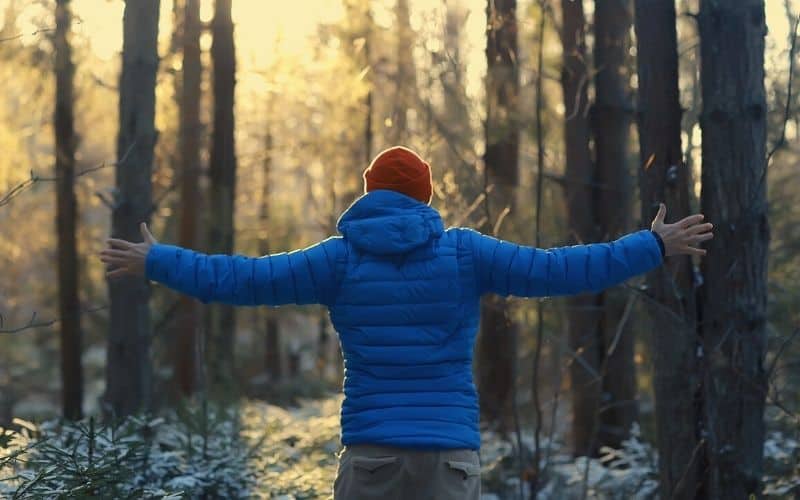
Warmth-to-weight Ratio
The most important factor to consider when choosing a new down jacket is the warmth-to-weight ratio, which refers to how much warmth the jacket provides relative to its weight.
The best down jackets provide high-quality insulation without being too bulky or heavy. But go too lightweight and you’ll risk losing durability and warmth. Finding the sweet spot is the name of the game.
The higher the fill power, the better the warmth-to-weight ratio. This is exemplified by the Arc’teryx Cerium LT, which has an FP of 850 and weighs just 7.6 oz. but is an amazingly warm jacket.

Comfort, Fit, Sizing, and Features
Comfort and features are the most subjective factors to consider when shopping for puffy jackets, but vitally important.
Your jacket fit snug, but not tight, to allow you to wear other layers underneath and a waterproof shell on top. Flexible materials like those used in the Rab Cubit allow for better mobility, an important feature if you’re adventuring in rough or technical terrain.
Your activity type is also important when considering sizing and fit. For alpinism or technical hiking, a snugger, more performance-oriented fit like the Rab Microlight Alpine or Arc’teryx Atom LT is ideal. For camping, skiing, or easy hiking then a more relazed fit like the REI 650 or Montbell Versatile will be more comfortable.
Besides getting the fit right, a few features can also boost the comfort of insulated jackets. Look for details like a fleece-lined chin guard, an elastic hood and wrist cuffs, lined pockets, one or two zippered chest pockets, and an adjustable hem to keep out drafts and custom-fit the waist around your belly and butt.
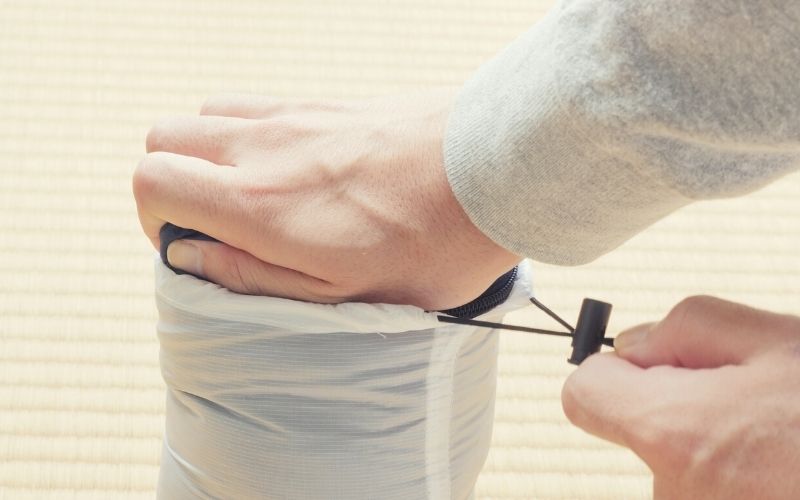
Compressibility and Packed Size
Another important consideration when buying your down jacket is compressibility. This refers to how packable the jacket is.
Heavier, thicker jackets are harder to compress, while lighter, thinner ones might take up no more pack space than a 1-liter water bottle.
But that’s not the full story…
Higher-fill-power down is more compressible. This means that if you take two jackets weighing 8 ounces, one with 900-fill and one with 650-fill down, the former will be far more packable than the latter.
Water Resistance
Water resistance isn’t the most important consideration when buying a down jacket, but it’s worth bearing in mind.
Most down jackets now use a durable water repellent finish to help you shake off light precipitation. Others, like the Rab Microlight Alpine, use hydrophobic down, which coats the feathers in a chemical so they absorb less water and dry faster.
These are expensive options that aren’t as water-resistant as synthetic alternatives, but worth it to stay dry and warm in a drizzle (not a downpour).
Durability And Materials
Another key factor when deciding between down jackets is durability, which mainly depends on the toughness of the outer fabric. This can be gauged by looking at the fabric density and the weave.
Fabric density is rated by the denier value (D). A higher denier rating means the shell fabric is heavier, but also stronger and more resistant to wear and tear. A 10D fabric, then, will be lightweight but fragile, while a 30D fabric will be heavier but more rugged.
And the weave? Shell fabrics are constructed using either a “ripstop” or regular weave, and ripstop weaves are by far the stronger of the two. A jacket like the MH Ghost Whisperer 2 that uses 10D nylon ripstop fabric, for example, will be far tougher than a model with a 10D regular weave.
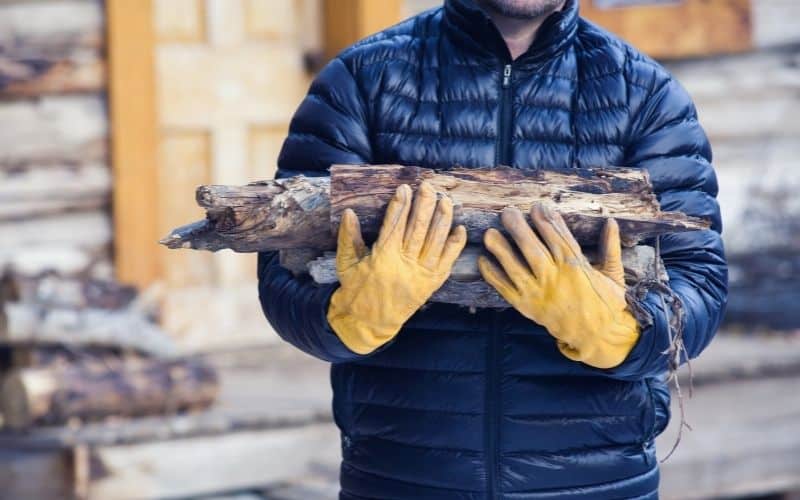
Sustainability
If sustainability and responsibly sourced material is an important factor to you, look for jackets made with recycled materials, have RDS certification, and/or approval from bluesign®.
Are Down or Synthetic Puffer Jackets Better?
The down vs synthetic jacket question can only be answered by refering to your priorities. Down is lighter and more compressible but usually costs significantly more. Most synthetic jackets have a poorer warmth-to-weight ratio but cost less and can insulate even when wet (down can’t).
How Should You Store and Care for Your Down Hoodie or Jacket?
To store and care for your down hoodie or jacket, hang it out of the stuff sack in a room with ample airflow. Every so often (depending on use), treat it to a down wash and reapply the DWR (durable water repellent) shell treatment.
What is the best packable women’s down jacket?
Our testers voted the Mountain Hardwear Ghost Whisperer 2 the best packable women’s down jacket. This featherweight hooded jacket boasts a performance-oriented design but is sleek enough for everyday wear. It’s also water resistant, has an excellent warmth-to-weight ratio, and is among the most packable down jackets out there.
Best Men’s Down Jackets: The Verdict
Now you know the details and specs of our top 9 puffy jackets (and one synthetic alternative) and you’re ready to choose the ideal insulator for your cold-weather adventures.
Still undecided which is best for you?
To recap, our pick of the bunch is the Mountain Hardwear Ghost Whisperer 2. This is, to our minds, the perfect puffy. It’s light, mobile, as comfortable as they come, and has an outstanding warmth-to-weight ratio.
If the price tag on that one’s a little too lofty, the next best thing is the Montbell Superior. This low-cost puffy, in short, does everything most of its far pricier competitors do and packs impressive warmth for such a lightweight insulated jacket.
We hope this guide has helped you find exactly what you’re looking for! Let us know in the comment section below and feel free to share this post with your friends!
